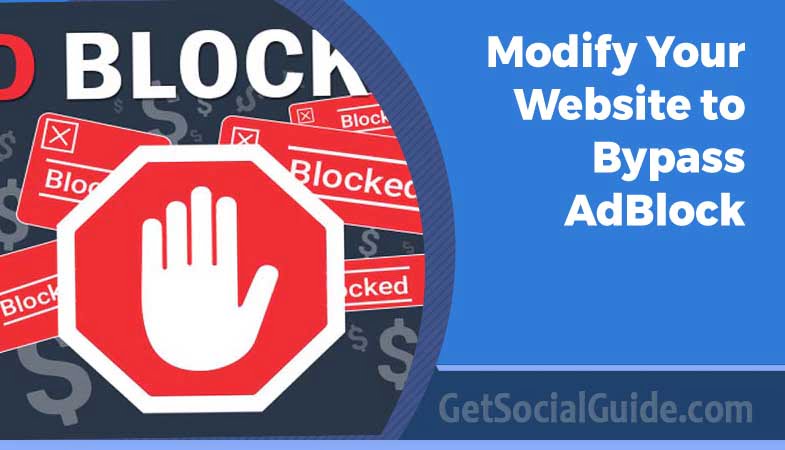Modify Your Website to Bypass AdBlock – Easy Guide
In today’s digital age, online advertising is a crucial component of businesses’ marketing strategies. However, AdBlock extensions have become increasingly popular, disrupting the display of ads and impacting advertising revenue. As website owners, understanding how to modify your website to bypass AdBlock is essential to ensure your ads reach your target audience. This article will delve into various techniques and best practices that can help you bypass AdBlock while maintaining a positive user experience.
Advantages of using AdBlock
Ad blocking is often considered beneficial for several reasons:
- Protection from Malicious Ads: Ad blocking software helps protect users from ads that may contain malware, viruses, or other harmful elements. This is particularly important as cybersecurity threats are a significant concern on the web.
- Improved User Experience: Ad blockers prevent sites from overloading pages with spammy, disruptive, or intrusive ads. Users appreciate a clean and uninterrupted browsing experience, especially when engaging in important tasks like research.
- Pressure on Sites to Improve Ad Quality: Ad blockers create a negative impact on sites that use excessive and annoying ads. In response to user demands for a better experience, websites may reduce the number of intrusive ads, leading to an overall improvement in ad quality.
- Enhanced Customization and Control: Many ad blockers offer additional functionalities beyond just blocking ads. Users can selectively block specific page elements, disable tracking cookies, stop auto-playing videos, and avoid social locking apps, giving them greater control over their online experience.
However, from a website owner’s perspective, ad blocking can lead to lost revenue, especially if the primary audience includes tech-savvy users who are more likely to employ ad blockers. Encouraging users to whitelist their sites or showing less intrusive and more relevant ads are some ways to address this issue and find a balance between monetization and user experience.
How Does Ad Blocker Detection Work?
Ad blocker detection works by using “bait content” to identify if a user has an active ad blocker. This bait content is designed to appear as if it were commercial content, making it indistinguishable from actual ads. When a webpage finishes loading, the detection algorithm calls to the properties of this bait content. If the bait content is hidden or blocked, the algorithm deduces that an ad blocker is active.
The process can vary, but in general, websites implement this detection algorithm to understand whether their users are blocking ads or not. If the detection identifies an ad blocker, the website may take various actions, such as displaying a message asking the user to disable the ad blocker or restricting access to content until the ad blocker is disabled.
However, it’s worth noting that ad blocker detection is not foolproof, and users can find ways to circumvent these detection methods. Some users employ browser extensions specifically designed to bypass ad blocker detection scripts, making it difficult for websites to accurately determine if an ad blocker is active or not. As a result, the battle between websites trying to monetize through ads and users seeking ad-free experiences continues to evolve.
How to Modify Your Website to Bypass AdBlock
To ensure your website effectively bypasses AdBlock and delivers your ads to users, consider implementing the following strategies:
1. Create User-Friendly Advertisements
One effective way to bypass AdBlock is to create user-friendly advertisements that provide value to visitors. Focus on generating engaging content and designing ads that seamlessly blend with your website’s layout. Avoid intrusive pop-ups or disruptive ads that may prompt users to install AdBlockers in the first place.
2. Implement Native Advertising
Native advertising is a subtle approach that integrates ads into the website’s content, making them appear as a natural part of the user experience. By using native ads, you can minimize the chances of AdBlock extensions flagging your advertisements.
3. Employ Asynchronous Loading
Using asynchronous loading techniques for ads ensures that they load independently of the main content. This way, even if AdBlock is present, there are better chances of the ads being displayed.
4. Utilize Server-Side Ad Insertion
Server-side ad insertion (SSAI) is an effective method to bypass AdBlock, as the ad content is delivered from the server, making it harder for AdBlock extensions to detect and block them.
5. Rotate Ad Domains
AdBlockers often detect and block ads by domain names. By rotating ad domains periodically, you can increase the likelihood of your ads being displayed.
6. Use HTML5 and CSS3 Animations
HTML5 and CSS3 animations for advertisements are less likely to be flagged by AdBlockers compared to Flash-based ads. This approach ensures your ads still reach your audience.
7. Employ Anti-AdBlock Scripts
Anti-AdBlock scripts can detect users with AdBlockers and trigger messages encouraging them to whitelist your website or disable the AdBlocker for an improved experience.
8. Leverage Adblock Blockers
Adblock blockers are tools designed to detect AdBlock extensions and request users to disable them to access your website. Be cautious not to use aggressive blockers that might frustrate users.
9. Use HTTPS for Ad Content
AdBlock extensions may be more inclined to block unsecured content. Ensure all ad content is served via HTTPS to minimize the chances of blocking.
10. Monitor and Adapt
Regularly monitor the performance of your ads and website regarding AdBlock usage. Stay up-to-date with the latest AdBlocker detection techniques and adapt your strategies accordingly.
FAQs
Can I bypass AdBlock without compromising the user experience?
Yes, you can bypass AdBlock while maintaining a positive user experience by focusing on non-intrusive, relevant, and native advertisements.
Are there any legal concerns when bypassing AdBlock?
Bypassing AdBlock should be done ethically and without violating any laws or regulations. Always respect users’ choices and privacy.
Will bypassing AdBlock work on all browsers and devices?
AdBlock bypass techniques may vary across browsers and devices, so it’s essential to test and optimize your strategies for different platforms.
Can I force users to disable AdBlock?
While it is possible to request users to disable AdBlock, forcing them may lead to negative feedback and a loss of trust.
Is it essential to educate users about the impact of AdBlock?
Educating users about the impact of AdBlock on your website’s revenue and the free content you provide can encourage them to whitelist your site.
Should I entirely rely on bypassing AdBlock, or are there alternative revenue sources?
Relying solely on bypassing AdBlock may not be sustainable. Consider exploring alternative revenue sources to diversify your income streams.
Conclusion
Modifying your website to bypass AdBlock requires a strategic and user-focused approach. By creating user-friendly advertisements, implementing native advertising, using asynchronous loading, and employing other effective strategies, you can increase the chances of your ads reaching your target audience. Remember to stay updated on the latest AdBlock detection techniques and maintain a positive user experience to build trust with your visitors. Now, you are well-equipped to take on the AdBlock challenge and optimize your website for successful ad delivery.




I am really pleased to glance at this blog posts which consists of lots of useful data, thanks for providing such data.
in think it is very informative blog and i like it
Great post. I am looking for this kind of post long time. Thanks